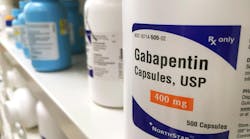It was early on a Sunday morning when I first received several notifications on Facebook about a “new” prescription drug abuse menace in America that was “killing thousands."
“What?!” I said to myself out loud. My initial shock was for two reasons. First, as a pharmacist, pharmacology educator, speaker, and author for more than 30 years, surely I would have heard of an issue with the illicit use of yet another prescription drug.
Second, after such major strides had recently been made in combatting the opioid epidemic in America, how was it possible that another prescription drug had slipped in so easily to replace opioids as the next “menace"?
Watch the video
Nevertheless, the notifications and warnings went viral and I watched them quickly spread from the web to broadcast media. The new menace was the prescription drug gabapentin, commonly known by its most popular brand-name, Neurontin. I must admit that initially these warnings struck me as a bit alarmist. “Gabapentin?!” I said to myself incredulously. “How can that be?”
What is gabapentin?
Gabapentin is an anti-seizure drug that is also prescribed for nerve pain. It has been available in the US since 1993. I was unaware of any widespread reports concerning any safety issues with it. Indeed, my quick review of the literature indicated that the first peer-reviewed report of any gabapentin-linked death was published in 2011 in the Journal of Forensic Sciences, and that was an intentional suicide by overdose.
Well, many prescription and non-prescription drugs taken in excessive amounts may cause death, even such innocuous drugs as aspirin and acetaminophen. Further review of the literature revealed yet another report of fatality by overdose, which was published the International Journal of Legal Medicine in 2015. However, these two reports hardly constituted thousands.
Also by Tom Viola:
Vaping: the new gateway drug and what dental professionals can do
‘But why? I feel fine!’
“So, what’s really going on here?” I pondered. Was this just social and broadcast media hysteria or is this based on a real abuse phenomenon? As it turns out, after my initial scratch of the surface, there was a lot for me to uncover about the truth behind these gabapentin warnings.
Since its introduction, gabapentin has been very popular and widely used as an adjuvant, an add-on drug that boosts the effects of other drugs, especially to help control partial seizures in adults. However, in the quarter century since its initial approval, off-label uses have exploded. It’s been prescribed to treat multiple physical conditions with neurological origins, from restless leg syndrome to nerve pain to acute and post-herpetic pain associated with shingles. It’s also prescribed for multiple psychiatric conditions, such as anxiety disorder, bipolar disorder, attention deficit disorder, and is even prescribed, somewhat ironically, in addiction treatment to reduce cravings and withdrawal symptoms.
Like almost all FDA-approved medications, when prescribed responsibly and taken as prescribed, gabapentin can offer great relief to those with these conditions. However, we all know that we live in a world in which not every patient takes medications as prescribed.
Why should dental professionals take notice?
We dental professionals must be aware of gabapentin’s rise as a drug of abuse, both alone and in combination with other substances. Why? Well, while the dangers of gabapentin to patients may have been somewhat overstated in the media, that doesn’t mean those dangers are not real.
Since gabapentin works so well as an adjuvant, it is also frequently used in combination with drugs of abuse to intensify their effects, especially opioids. In July 2017, a report in Kaiser Health News detailed the dangers of recreational drug users taking high doses of gabapentin along with opioids, a practice called stacking. Interestingly, in this report many users were also found to be taking gabapentin all by itself, in place of opioids, to get high and stay high during rehab, thereby escaping detection during mandatory opioid drug screenings (which doesn’t yet screen for gabapentin).
In 2016, a literature review in the journal Addiction reported that only 1% of the general population misuses gabapentin. However, among people with prescriptions for the drug, that number soared to 40% to 65%. In addition, it was noted that among people who abuse opioids, the percentage that also abuses gabapentin was estimated to be between 15% and 22%. Also in that year, the state of Kentucky released data gathered from autopsies performed on people who died of drug overdoses. The data revealed the presence of gabapentin alongside deadly opioids such as heroin and fentanyl. In fact, gabapentin was the most frequently detected substance in these autopsies.
So, what’s the danger? Well, when used recreationally in this way, gabapentin is often taken in doses that are much greater than its typical legitimate therapeutic dose. Some users report taking up to 5,000 milligrams at once, which is nearly 2.5 times the usual prescribed daily dose of 1,800 mg. At those high doses, gabapentin, like many other anti-seizure medications, may produce exaggerated adverse effects, including, counterintuitively, seizures.
In this respect, this issue with gabapentin seems to represent a bit of a perfect storm. First, gabapentin is prescribed for pain, and since no health professional wants to see a patient in pain, this may foster a bit of leniency when it comes to prescribing practices and quantity limits for this drug.
Second, gabapentin is often prescribed off-label, so this may foster a bit of an “anything goes” and “let’s try it and see if it works” feeling among prescribers and their patients, encouraging experimentation with doses and dosing frequency.
Third, gabapentin is not a controlled substance, and thus, since the usual guidelines and restrictions for prescribing and dispensing large quantities of such substances don’t apply to gabapentin, this may foster less oversight of its use and fewer warnings for its potential abuse.
Fourth, gabapentin is not an opioid and this may foster a relative, and false, sense of safety about its use and reduce concerns about its potential for abuse
Finally, since gabapentin is often prescribed in large quantities and covered by most prescription plans with a low generic drug copay, it is relatively inexpensive and widely available for both its prescribed use as well as for experimentation for abuse.
Recreational gabapentin abuse (with or without a prescription) needs to be on the radar of dental professionals due to its potential for producing not only additive adverse effects, but also serious drug-drug interactions with medications we commonly use during dental procedures, such as for conscious-sedation or the treatment of post-operative pain. Even when used for legitimate reasons, gabapentin taken in combination with opioids increases the risk of respiratory depression and death.
It’s important to ask patients about all prescription and non-prescription medication use when reviewing their medical histories. Keep in mind that while patients may not be willing to admit to abusing opioids or other substances, they might be willing to admit gabapentin use. That could make it easier for us to identify those patients who may be at elevated risk during and after dental procedures.
Editor's note: Originally published in 2018 and updated as of March 2025.





